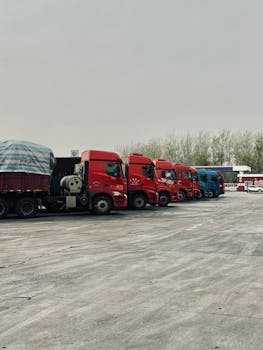
Global Shift: Major Countries Protect Small Cars Amidst Tightening CAFE Standards – Nomura Report Reveals
The automotive industry is undergoing a seismic shift, driven by increasingly stringent Corporate Average Fuel Economy (CAFE) standards globally. A recent report by Nomura, a leading financial services group, sheds light on a surprising trend: major countries are implementing measures to shield smaller vehicles from the full impact of these stricter regulations. This strategic move raises crucial questions about the future of fuel efficiency, electric vehicle (EV) adoption, and the overall automotive landscape.
CAFE Standards: A Global Push for Fuel Efficiency
Corporate Average Fuel Economy (CAFE) standards are government regulations designed to improve the average fuel economy of a manufacturer's vehicle fleet. These standards are crucial in combating climate change by reducing greenhouse gas emissions from the transportation sector. Countries worldwide, including the US, China, the European Union (EU), Japan, and India, are tightening these standards, forcing automakers to innovate and produce more fuel-efficient vehicles. This includes a push towards electric vehicles (EVs), hybrid electric vehicles (HEVs), and plug-in hybrid electric vehicles (PHEVs).
The Growing Pressure on Automakers
The intensifying CAFE regulations present a significant challenge to automakers. Meeting these targets requires substantial investment in research and development (R&D) for cleaner technologies, impacting both production costs and profitability. This pressure is particularly acute for manufacturers heavily reliant on larger, less fuel-efficient vehicles.
Nomura's Findings: Protecting Small Cars in a Changing Market
Nomura's insightful report highlights a key strategy employed by many countries to navigate the complexities of rising CAFE standards: protecting smaller, more fuel-efficient vehicles. This approach involves several methods, including:
Credit Systems: Many jurisdictions utilize credit systems where the fuel efficiency of certain vehicles, often smaller cars, can generate credits that offset the emissions of larger, less efficient models within the manufacturer's overall fleet. This effectively allows manufacturers to balance their portfolio and meet CAFE targets without completely phasing out less fuel-efficient vehicles.
Differentiated Standards: Some countries have implemented differentiated CAFE standards based on vehicle size or weight. Smaller cars often face less stringent requirements compared to SUVs and trucks, providing a degree of protection in the face of tightening regulations.
Targeted Incentives: Governments are offering incentives for the production and sale of smaller, fuel-efficient vehicles, directly supporting their continued presence in the market. These incentives can include tax breaks, subsidies, and other financial support mechanisms.
The Rationale Behind Shielding Smaller Cars
The rationale behind this seemingly contradictory approach is multifaceted:
Affordability: Small cars are often more affordable, making them accessible to a larger segment of the population. Protecting these vehicles ensures continued mobility for a broader range of consumers.
Urban Mobility: Small cars are highly suited for urban environments, where they offer better maneuverability and parking convenience. Their continued production addresses the specific transportation needs of densely populated areas.
Fuel Efficiency Baseline: Smaller cars provide a crucial baseline for fuel economy. By ensuring their continued production, countries establish a foundation for improving the overall fuel efficiency of their vehicle fleets.
Implications for the Automotive Industry and Consumers
Nomura's report underscores the complex interplay between environmental regulations, economic considerations, and consumer preferences. The strategic shielding of small cars suggests that a complete transition to larger, electric vehicles might not be as rapid or seamless as some projections suggest.
Challenges and Opportunities
This strategy presents several challenges and opportunities for automakers:
Investment Diversification: Automakers need to balance investments in electric vehicle technology with the continued production of fuel-efficient smaller cars to meet varying regulatory requirements and consumer demands.
Technological Innovation: The focus on smaller vehicles doesn't negate the need for technological innovation. Automakers must continue to improve the fuel efficiency of smaller cars using advanced technologies such as lightweight materials and improved engine designs.
Market Segmentation: A nuanced understanding of market segmentation is crucial for automakers to effectively cater to the needs of consumers with diverse preferences and budgets.
Consumer Impact
Consumers will continue to have a diverse range of choices in terms of vehicle size and type, despite tightening CAFE standards. However, they should expect to see a continued shift towards more fuel-efficient vehicles overall, regardless of size, reflecting the global push for environmental sustainability.
The Future of CAFE Standards and Small Cars
The future of CAFE standards and the role of small cars remain intertwined. While the global push towards stricter regulations will undoubtedly accelerate the adoption of EVs and other clean technologies, the strategic protection of smaller vehicles suggests a more gradual transition than some may anticipate. This approach recognizes the importance of affordability, urban mobility, and the need for a balanced approach to meeting environmental goals without disrupting the automotive market entirely.
Nomura's report provides valuable insights into the evolving strategies employed by governments worldwide to balance environmental concerns with economic realities and consumer preferences. It highlights the dynamic nature of the automotive industry and underscores the importance of considering diverse approaches to achieving sustainable transportation solutions. The ongoing developments in CAFE standards and the role of smaller cars will undoubtedly shape the automotive landscape for years to come, demanding continuous adaptation and innovation from automakers and policymakers alike. Further analysis of specific regional policies and their impact on the market will be crucial to fully understanding the implications of this evolving landscape.



















